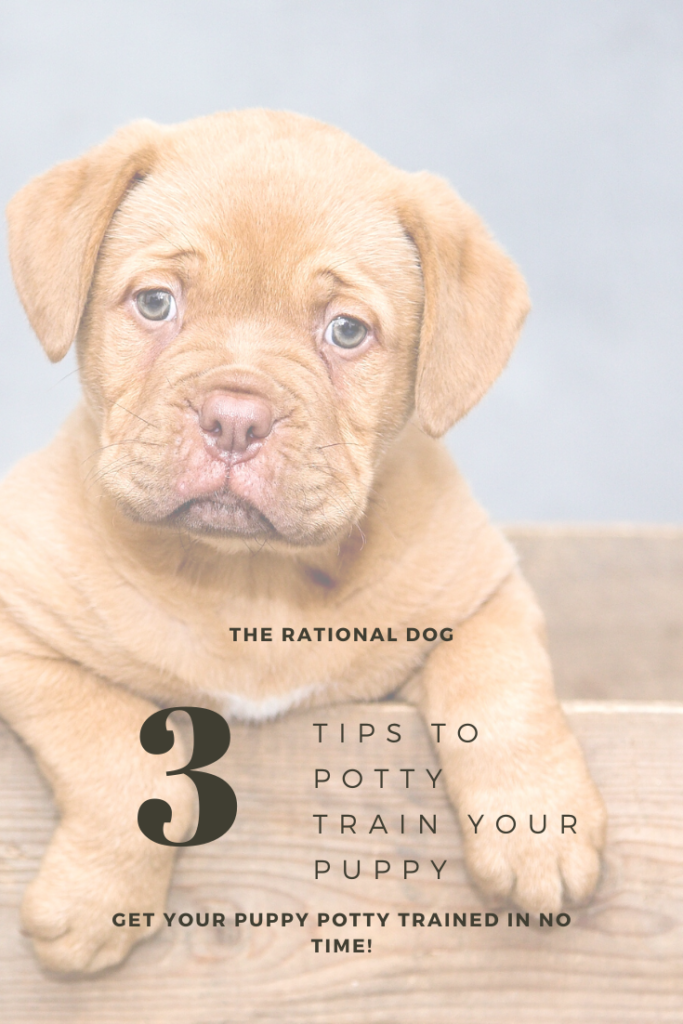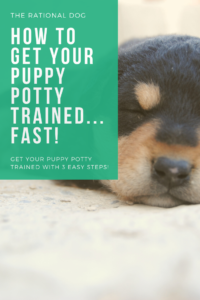When you bring home a new dog, whether it’s a new puppy or an older dog, invariably one of the most important things your dog needs to know is where to go potty. Even if your dog is the best behaved dog in the world, they can completely ruin your home without proper potty training.

Often, an owner is willing to put up with a whole lot of misbehavior on the part of their dog, but that one issue is the one that they find to be most frustrating. If you are dealing with some potty training troubles, this post will help give you some insight into the most common mistakes that folks make, and some super simple fixes to get your dog going where you want them to.
Want to learn my top tips for a well behaved dog? Click here to get access to my FREE mini-course!
The major challenge of potty training is to explain to your young puppy that the only place to go is outside, or on a pad. Just a note: unless you have a small dog that is going to spend the majority of its time inside, I really don’t recommend pad training. It can be a big challenge to wean the dog away from using the pads when you decide you’d like them to go outside. Instead, I recommend starting right off with getting your pup on a schedule for going outside. Using your dog’s innate instincts regarding territory is going to make your job in potty training your pup a whole lot easier. Here are three quick and easy tips to get you started on the track to potty training success.
Use a Crate.
Whether you are potty training a young puppy, or you are working with an older dog that hasn’t learned how things are done yet, a crate is going to be your very best friend. For the most part, unless your dog becomes confused by inconsistency in your expectations, dogs will not go potty in the spot where they rest, as long as it is small enough. Having an extra large sized crate for a chihauha, for example, will probably not be successful. However, using a correctly sized crate encourages your dog to hold it until they are able to go outside and relieve themselves.
The other big reason for using a crate, particularly when your dog or puppy is unsupervised, is that it cuts down on the mistakes that your dog is able to make in your house with accidents, and therefore on the cleaning that you have to do (and flooring you need to replace, in extreme circumstances). When you are home with your pup, you are able to see when he starts to circle and sniff, good indicators that some pottying is about to happen. But, when you’re not there to keep tabs, there is no one there to open the door and go out with your pup.
If you do not use a crate at home, we’ll talk about that in a separate post. However, when you are dealing with a potty training issue, either having a crate or a small pen or gated area set up is going to save your home and your relationship with your dog. Since your pup will usually not potty in their resting area unless it’s an absolute emergency, using one teaches your dog how to hold it and get onto a potty schedule. If you are a person who feels guilty about using a crate for this, I suggest that you consider how you will feel when you’ve finally had enough and feel you need to find a new home for your beloved dog.
Stick to a Schedule.
When you are first starting out on your potty training journey, it is very helpful to stick to a pretty predictable schedule for your puppy. For young puppies, a good rule of thumb is that however many months old your pup is, that’s how many hours they should be able to hold it between potty breaks. So a three month old puppy should be able to hold it for three hours, a four month old should be able to hold it for four hours, and so on.
My schedule for my new puppy looks like this: Wake up in the morning, out to potty and play. Inside to eat and rest in crate. When she wakes up again, outside to potty and play, then she comes inside to play and hang out in the house. Then either into her crate to nap, or if she falls asleep while playing, sleeping in the house. As soon as she wakes up, back outside to potty and play. This rotates around all throughout the day. Every time she wakes up from a rest, she needs to go outside for potty and playtime. And she is not allowed to be loose in the house until AFTER she has gone potty outside. We will get to that in a minute.
When you’re creating a schedule for your dog to follow, just keep in mind their age, and the fact that they’ll need to go out and potty every time they’re brought out of their pen, crate, or they wake up from a nap.

Play Outside.
This one probably seems silly, but let me explain. When I get called for a potty training issue, probably 8 out of 10 stories sound like this:
“I take my puppy outside to go potty, but he doesn’t go. He sniffs around and plays, but won’t stop to pee or poop. I figure that he didn’t have to go after all, so I bring him back inside, and he immediately stops and pees. It’s driving me crazy!”
So why is this such a common story? Well, let’s look at things from the perspective of your dog, and it will all make sense.
Puppies like to be outside, right? All of those smells, the running around, the digging, the playing. It’s just the best feeling in the world to be an outside dog. Even better if they’re there with YOU, their favorite person! But when we are potty training a dog, a lot of the time we fall into this pattern of taking the pup out, letting them potty, and bringing them right back inside.
If we look at it from your dog’s perspective, the second that they stop to go potty, the fun ends. All of their playing and smelling and outside dog joy time is over. A lot of dogs make this cause and effect connection between doing their business and their fun ending, and so they will hold it to prolong their playtime. Pretty smart, actually, when you think of it like that.
Luckily, this one is a pretty easy fix, as long as your dog isn’t completely set in the pattern of holding it. That’s when things get hairy, and I’ve got some help coming to you to solve that big problem shortly with my Potty Training Guide. But when your dog does go outside, take some time, 5-10 minutes at least, to let them run and play afterwards. Throw the ball, play chase or tug, or just let them sniff for awhile while you read an email on your phone. This will break the dog’s connection between going potty outside and being immediately forced to come back in.

Want to be kept in the loop, so you are the first to know when my Potty Training Course is available? Join my newsletter here!
So there you have it. Three simple tips to help make potty training your pup go smoothly. If you are having some more complex troubles with your pup going outside, shoot me a comment, and we can work it out!
Very good approach. I would like to recommend to my puppy people. Please send me links.
Thank you! Feel free to join my email list here, and you will get updates with every post that I create here to pass along to your puppy people! The link to this post is http://therationaldog.com/3-tips-to-potty-train-your-puppy/
Awesome post! Keep up the great work! 🙂